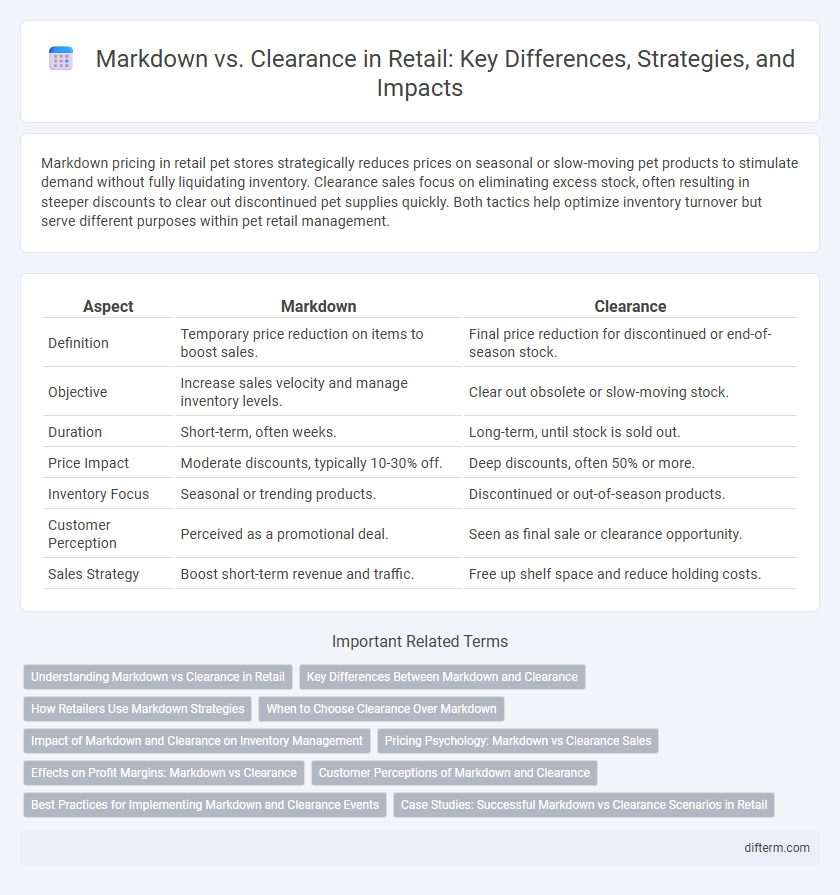Markdown pricing in retail pet stores strategically reduces prices on seasonal or slow-moving pet products to stimulate demand without fully liquidating inventory. Clearance sales focus on eliminating excess stock, often resulting in steeper discounts to clear out discontinued pet supplies quickly. Both tactics help optimize inventory turnover but serve different purposes within pet retail management.
Table of Comparison
| Aspect | Markdown | Clearance |
|---|---|---|
| Definition | Temporary price reduction on items to boost sales. | Final price reduction for discontinued or end-of-season stock. |
| Objective | Increase sales velocity and manage inventory levels. | Clear out obsolete or slow-moving stock. |
| Duration | Short-term, often weeks. | Long-term, until stock is sold out. |
| Price Impact | Moderate discounts, typically 10-30% off. | Deep discounts, often 50% or more. |
| Inventory Focus | Seasonal or trending products. | Discontinued or out-of-season products. |
| Customer Perception | Perceived as a promotional deal. | Seen as final sale or clearance opportunity. |
| Sales Strategy | Boost short-term revenue and traffic. | Free up shelf space and reduce holding costs. |
Understanding Markdown vs Clearance in Retail
Markdown in retail refers to the deliberate reduction of a product's price to stimulate sales or clear inventory without necessarily discontinuing the item, often used as a strategic pricing tool during regular sales events. Clearance involves deeply discounted pricing aimed at permanently removing end-of-season or discontinued merchandise from stock to make room for new inventory. Differentiating between markdown and clearance is essential for inventory management and maximizing profit margins, as markdowns target ongoing sales while clearance signals final liquidation.
Key Differences Between Markdown and Clearance
Markdown reduces the price of current inventory to boost sales without removing the product from regular offerings, often applied strategically to seasonal or slow-moving items. Clearance pricing eliminates products from the assortment entirely, typically featuring steep discounts to quickly sell off end-of-line stock, discontinued items, or excess inventory. The key difference lies in markdowns maintaining product presence in the market, while clearance signals the final selling phase before goods are removed.
How Retailers Use Markdown Strategies
Retailers use markdown strategies to efficiently manage inventory by reducing prices on seasonal or slow-moving products, thereby boosting sales and freeing up shelf space. Markdowns are often temporary price reductions aimed at stimulating demand, while clearance involves deeper discounts to quickly sell off excess stock. Implementing targeted markdowns based on sales data and customer behavior helps retailers optimize profit margins and maintain a dynamic product assortment.
When to Choose Clearance Over Markdown
Clearance should be chosen over markdown when inventory needs to be quickly liquidated to free up storage or capitalize on seasonal demand shifts, as it signals final price reductions to customers. Retailers prioritize clearance for products that are obsolete, out-of-season, or discontinued, where maximizing turnover is more critical than maximizing profit margin. Using clearance strategically minimizes holding costs and accelerates cash flow, ensuring retail space is efficiently allocated for new merchandise.
Impact of Markdown and Clearance on Inventory Management
Markdowns reduce product prices to stimulate sales and accelerate inventory turnover, helping retailers manage stock levels efficiently. Clearance sales target slow-moving or obsolete items, enabling quick liquidation and freeing up shelf space for new inventory. Both strategies optimize inventory by minimizing holding costs and improving cash flow in retail operations.
Pricing Psychology: Markdown vs Clearance Sales
Markdown pricing leverages moderate discounts to influence consumer perception of value, encouraging purchases without devaluing the brand. Clearance sales use steep price reductions to quickly liquidate inventory, signaling urgency and a final opportunity to buy. Understanding the psychological impact of these strategies helps retailers balance sales velocity with brand equity.
Effects on Profit Margins: Markdown vs Clearance
Markdowns typically involve small, incremental price reductions to boost sales while maintaining healthier profit margins, whereas clearances often require steep discounts that significantly erode profit margins to quickly liquidate inventory. Effective markdown management balances inventory turnover with maintained profitability, while clearance strategies prioritize rapid inventory depletion, often at the expense of short-term margins. Retailers must strategically decide between markdowns and clearance based on product lifecycle, demand patterns, and overall margin impact.
Customer Perceptions of Markdown and Clearance
Customers often perceive markdowns as temporary discounts signaling good deals, while clearance items are viewed as final opportunities to purchase discontinued or seasonal stock. Markdowns can create a sense of urgency without devaluing the brand, whereas clearance sales may sometimes suggest overstock or less desirable merchandise. Understanding these perceptions helps retailers tailor pricing strategies and improve customer satisfaction in competitive retail environments.
Best Practices for Implementing Markdown and Clearance Events
Effective markdown and clearance strategies in retail require precise inventory analysis to identify slow-moving or seasonal products, enabling timely price reductions that maximize revenue without eroding brand value. Implementing dynamic pricing tools and data-driven demand forecasting optimizes markdown timing and depth, ensuring clearance events efficiently clear stock while maintaining profit margins. Clear communication through targeted promotions and in-store signage enhances customer engagement, driving sales volume during these events and improving overall inventory turnover.
Case Studies: Successful Markdown vs Clearance Scenarios in Retail
Case studies in retail reveal that successful markdown strategies optimize inventory turnover by targeting slow-moving items with precise timing and tailored discounts, enhancing overall profit margins. Clearance events effectively liquidate end-of-season stock, freeing up space for new merchandise but often result in lower revenue per unit sold. Retailers leveraging data analytics to balance markdown frequency and clearance depth achieve improved inventory health and sustained customer engagement.
markdown vs clearance Infographic

 difterm.com
difterm.com